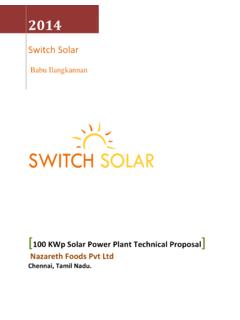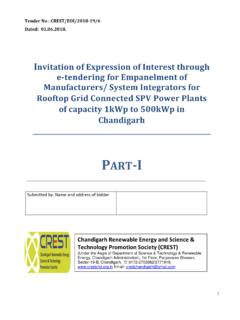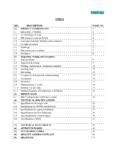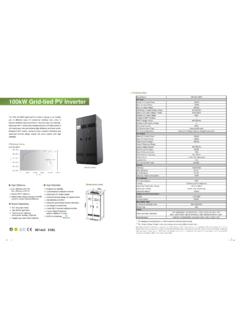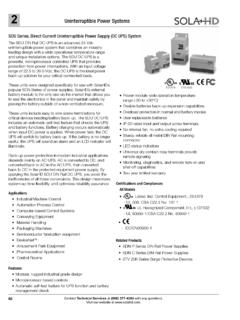Transcription of Guidelines for Grid-connected Small Scale …
1 Guidelines for Grid-connected Small Scale ( rooftop ) solar PV. Systems for Tamil Nadu Version: April 2014. Scope and Purpose These Guidelines for Grid-connected Small Scale ( rooftop ) solar PV systems have been prepared for the benefit of departments and organizations of the Government of Tamil Nadu that plan to install these systems for their office buildings. This document is a guideline document only and the Government Departments and Organizations may make suitable modifications to these documents to meet their specific (process) requirements. Grid-connected solar PV Systems There are basically two solar PV systems: stand-alone and Grid-connected . Stand-alone solar PV systems work with batteries. The solar energy is stored in the battery and used to feed building loads after conversion from DC to AC power with a stand-alone inverter. These systems are generally used in remote areas without grid supply or with unreliable grid supply.
2 The disadvantage of these systems is that the batteries require replacement once in every 3 5 years. Grid-connected solar PV systems feed solar energy directly into the building loads without battery storage. Surplus energy, if any, is exported to the TANGEDCO grid and shortfall, if any, is imported from the grid . These Guidelines apply to Grid-connected Small Scale ( rooftop ) solar PV systems. solar Net-metering In Tamil Nadu a facility known as net-metering has been introduced. In net- metering the solar energy exported to the grid is deducted from the energy imported from the grid subject to certain conditions. The consumer pays for the net-energy imported from the grid . To enable net-metering TANGEDCO will replace the existing service connection meter with a bidirectional meter that displays the import and export energy separately. For details of net-metering please see the relevant order of the Tamil Nadu Electricity Regulatory Commission (TNERC) of 13-11-2013 ( ).
3 rooftop and Installation Requirements The shadow-free area required for installation of a rooftop solar PV system is about 12 m2 per kW (kilowatt). This number includes provision for clearances between solar PV array rows. The solar panels may be installed on the roof of the building with a south facing tilt angle that varies in Tamil Nadu from 11 13. degrees depending on the latitude of the location. Sufficient area shall be available for servicing the system. The minimum clearance required for cleaning and servicing of the panels is from the parapet wall and in between rows of panels. In between the rows of solar panels sufficient gap needs to be provided to avoid the shading of a row by an adjacent row. The solar grid inverter shall be placed indoor in a safe and easily accessible place. Capital Subsidy by the Ministry of New and Renewable Energy (MNRE).
4 The Ministry of New and Renewable Energy of the Government of India provides capital subsidies for solar PV systems subject to certain conditions. As of date (March 2014) the capital subsidy for rooftop solar PV systems is 30% of the benchmark cost or 30% of the actual cost, whichever is less. The up-to-date Page 1 of 16. benchmark cost and capital subsidy terms and conditions may be checked on the website of MNRE (see: ). System Components A Grid-connected solar PV system consists of the following main components: solar PV (photo-voltaic) array solar PV array support structure solar grid inverter Protection devices Cables solar PV System Capacity Sizing The size of a solar PV system depends on the 90% energy consumption of the building and the shade-free rooftop (or other) area available. A guideline for calculating the solar PV system size is given in Annexure 1.
5 Technical Specifications and Tender Eligibility Criteria TEDA has developed General Technical Specifications and Tender Eligibility Criteria for Small Scale ( rooftop ) Grid-connected solar PV systems. See Annexure 2 and 3. Page 2 of 16. Annexure 1. Small Scale ( rooftop ) solar PV system capacity sizing solar Array Capacity The capacity of a solar PV array (in kWp, kilowatt-peak) depends90% energy consumption of the building on and the shade-free rooftop (or other) area available. Assumptions The roof (or elevated structure) area requirement per kW of solar PV modules is about 12m2. In Tamil Nadu the typical average annual energy generation per installed kW. of solar PV capacity is 1,500 kWh. (This number assumes a system capacity utilization factor of 18% and average grid availability of 95% during the daytime). As per the Tamil Nadu solar net-metering policy, electricity generated from a solar rooftop / solar system and injected into the TANGEDCO grid shall be capped commercially at 90% of the electricity consumption by the eligible consumer at the end of a 12 month settlement period which is from August to July.
6 Excess energy generated beyond the 90% cap shall be treated as lapsed and will not be credited for the purpose of net-metering. With these assumptions, the recommended capacity of the solar modules array of a proposed Grid-connected solar PV system can be calculated with the following three steps. Step 1: Calculate the maximum system capacity on the basis of the shade- free rooftop area. Formula: Capacity = shade-free rooftop area (in square meters) divided by 12. Example: The shade-free rooftop area is 60 m2. The maximum solar PV capacity that can be installed on this rooftop area would be 60 / 12 = 5 kWp Step 2: Calculate the system capacity based on annual energy consumption. Formula: Capacity = 90% of annual energy consumption (in kWh) divided by 1,500. Example: The (estimated) annual energy consumption is 15,000 kWh The solar PV system capacity based on annual energy consumption would be (90% x 15,000) / 1,500 = 9 kWp Recommended Capacity : Take the lowest of the above two capacity calculation results.
7 In this example: 5 kWp solar grid Inverter Capacity The recommended solar grid inverter capacity in kW shall be in a range of 95% - 110% of the solar PV array capacity. In the above example, the solar array Page 3 of 16. capacity was calculated to be 5 kW. The solar grid inverter required for this array would be in a range of kW. In Tamil Nadu for systems above 4 kW, three phase solar grid inverters shall be used (three single phase inverters or a single three phase inverter). Page 4 of 16. Annexure 2. General Technical Specification for Small Scale ( rooftop ) solar PV. systems Introduction In Grid-connected solar photo-voltaic (PV) systems, solar energy is fed into the building loads that are connected to the TANGEDCO grid through a service connection with surplus energy being fed into the grid and shortfall being drawn from the grid . Production of surplus energy may happen when solar energy produced exceeds the energy consumption of the building.
8 This surplus is fed into the grid . During the night, or when during the day energy demand in the building exceeds solar energy generation, energy is drawn from the grid . Grid-connected solar PV. systems have no battery storage and will not work during grid outage. For buildings with Grid-connected solar PV systems, the service connection meter needs to be of the bidirectional type, whereby import kWh and export kWh are separately recorded. A Grid-connected solar PV system consists of the solar panels, solar panels mounting structure, one or more solar grid inverters, protection devices, meters, interconnection cables and switches. Components and parts used in solar PV systems should conform to the BIS. or IEC or other international specifications, wherever such specifications are available and applicable. Quality and Workmanship solar PV modules are designed to last 25 years or more.
9 It is therefore essential that all system components and parts, including the mounting structures, cables, junction boxes, distribution boxes and other parts also have a life cycle of at least 25 years. Therefore all works shall be undertaken with the highest levels of quality and workmanship. During inspection special attention will be given to neatness of work execution and conformity with quality and safety norms. Non compliant works will have to be redone at the cost of the Installer. System Sizing As per the solar net metering orders of the Tamil Nadu Electricity Regulatory Commission (TNERC) of 13-11-2013, crediting of energy for the purpose of net-metering is limited to 90% of the consumed energy during a 12 month settlement period. The maximum recommended solar PV capacity for Grid-connected solar PV systems is therefore a capacity that produces not more than 90% of the annual energy consumption of the building.
10 Page 5 of 16. Specification of solar PV Modules solar PV modules shall be of the crystalline silicon type, manufactured in India. Detailed specifications of the solar PV modules are given below: Type Crystalline silicon Origin Manufactured in India Efficiency >= 13%. Fill factor >= 70%. Degradation warranty Panel output (Wp) capacity to be >=90% of design nominal power after 10 years and >=80% of design nominal power after 25 years. Module frame Non-corrosive and electrolytically compatible with the mounting structure material Termination box Thermo-plastic, IP 65, UV resistant Blocking diodes Schottky type Module minimum rated power The nominal power of a single PV. module shall not be less than 74Wp. RF Identification tag for each Shall be provided inside the module solar module and must be able to withstand environmental conditions and last the lifetime of the solar module.



